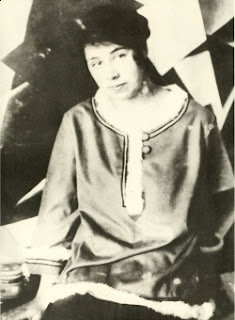The Unfinished Life of Lyubov Popova
When I visited the Revolution exhibition of Russian art at the Royal Academy, one of the artists that interested me most was a woman called Lyubov Popova. Her paintings were striking and very beautiful. But there were only a few and even fewer details of her life. I wondered why. What had happened to Popova?
On the internet I uncovered the story of her life. She was born into a wealthy and highly educated family in 1889. Her father was a textile merchant and patron of the arts. Her mother also came from an artistic family. Popova's precocious talent was encouraged from the beginning. Initially she was taught at home, then at the Gymnasium in Moscow before entering the private studios of some of the best artists in Russia, studying Cubism and Futurism, developing her own blend which she called Architectonics.
Popova travelled widely in Russia looking at the tradition of Icon painting. She was also interested in European Renaissance art - particularly Giotto - and in 1913 she went to Paris to study there, following this with a tour of France and Italy, returning after the outbreak of war in 1914. She studied with Cubists Henri Le Fauconnier and Jean Metzinger. Her privileged background made all of this possible.
Initially the war and the increasing instability in Russia had little effect on Popova. She became interested in Constructivism and worked for a while in the same studio as Vladimir Tatlin. Then she was admitted to the studio of Kazimir Malevich who was an enormous influence on her.
The lives of every artist in Russia changed with the revolution in 1918. After this, the approval of the State was necessary for your work. Many were unable to work under its restraints and left. Popova remained. In 1918 she married the art historian Boris Eding, with whom she had a son. The following year, with Russia in chaos, Eding died of typhoid fever. Popova was ill, but recovered.
Popova continued to paint, but began, like many other artists, to use her talents to design everyday objects. She was particularly interested in fabric and fashion. Her paintings reflect this fascination with patterns. Popova, alongside another female artist, Stepanova, laid down strict conditions for working as artists in commercial conditions, trying to achieve a measure of artistic freedom.
In 1924, Popova's young son contracted Scarlet Fever and died. Two days later Popova also died - the life and career of a brilliant artist cut short. She was only 34. Her younger brother, Pavel, became the guardian of her estate and reputation. As with the author Katherine Mansfield, who died at the same age and almost in the same year, it would be very tempting to go into the 'might-have-beens', but instead it is better to look at what had already been achieved. Lyubov Popova left a huge body of work, some of it utterly stunning.
The Life and work of Lyubov Popova
Lyubov Popova - Encyclopaedia Britannica
Exhibition history - MOMA
 |
| Lyubov Popova photograhed by Alexander Rodchenko |
 |
| Lyubov Popova - Architectonic |
 |
| Lyubov Popova - Female Study |
Initially the war and the increasing instability in Russia had little effect on Popova. She became interested in Constructivism and worked for a while in the same studio as Vladimir Tatlin. Then she was admitted to the studio of Kazimir Malevich who was an enormous influence on her.
The lives of every artist in Russia changed with the revolution in 1918. After this, the approval of the State was necessary for your work. Many were unable to work under its restraints and left. Popova remained. In 1918 she married the art historian Boris Eding, with whom she had a son. The following year, with Russia in chaos, Eding died of typhoid fever. Popova was ill, but recovered.
Popova continued to paint, but began, like many other artists, to use her talents to design everyday objects. She was particularly interested in fabric and fashion. Her paintings reflect this fascination with patterns. Popova, alongside another female artist, Stepanova, laid down strict conditions for working as artists in commercial conditions, trying to achieve a measure of artistic freedom.
In 1924, Popova's young son contracted Scarlet Fever and died. Two days later Popova also died - the life and career of a brilliant artist cut short. She was only 34. Her younger brother, Pavel, became the guardian of her estate and reputation. As with the author Katherine Mansfield, who died at the same age and almost in the same year, it would be very tempting to go into the 'might-have-beens', but instead it is better to look at what had already been achieved. Lyubov Popova left a huge body of work, some of it utterly stunning.
The Life and work of Lyubov Popova
Lyubov Popova - Encyclopaedia Britannica
Exhibition history - MOMA






Wow what a lot she crammed into a short life. Inspiring and so very colouful. Thanks Kathleen.
ReplyDeleteThank you!
ReplyDelete